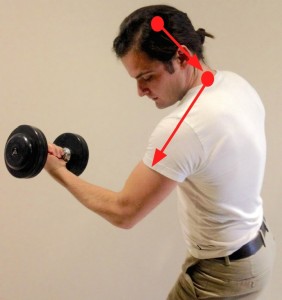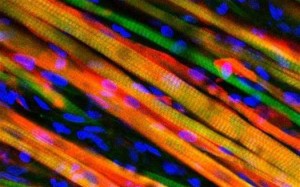
During strength training, output from the motor cortex is repeatedly sent down to the spinal cord to cause muscle contraction.
Strength training consists of repetitive high-force muscle contractions. Strength training for four weeks improves maximal strength (Carroll et al. 2011). These strength gains are primarily the consequence of changes in the nervous system and are not simply due to an increase in muscle size (e.g., Weier et al. 2012). In fact, within 30 minutes of completing one session of strength training, muscle twitch forces evoked by stimulation of the motor cortex increase toward the training direction and in magnitude (Selvanayagam et al. 2011). Although the motor cortex has been implicated as the site which mediates early strength gains with training (e.g., Hortobagyi et al. 2009; Weier et al. 2012), the spinal cord is also likely to play a role. However, it has been difficult to separate changes that happen in the motor cortex from those that happen in the spinal cord. Thus, we set out to answer two questions: (1) does the spinal cord become more excitable after one session of strength training and (2) does the type of strength training play a role?
To answer these questions, we asked able-bodied participants to complete single sessions of different types of strength training. Training was performed with the upper-arm muscles and involved slow muscle contractions on one day and fast contractions on another. To assess spinal cord excitability, we applied electrical pulses across the base of the skull to stimulate the corticospinal nerve fibres that carry signals from the brain to the motoneurones in the spinal cord. We measured the size of muscle responses evoked by this stimulation.
WHAT DID WE FIND?
We found that excitability of the spinal cord increased for 15 to 25 minutes after one session of strength training. This effect was observed after training with slow or fast contractions.
SIGNIFICANCE AND IMPLICATIONS:
Our novel result is the identification of the spinal cord as a site that undergoes early change with strength training. The increased excitability in the spinal cord after training implies that the muscles involved with training may become easier to activate. Such adaptations may be especially important for patients who have neurological conditions that impair muscle activation and strength (e.g. spinal cord injury, stroke).
PUBLICATION:
Nuzzo JL, Barry BK, Gandevia SC, Taylor JL (2015). Acute strength training increases responses to stimulation of corticospinal axons. Med Sci Sports Exerc (In Press).
KEY REFERENCES:
Carroll T, Selvanayagam V, Riek S, Semmler J (2011). Neural adaptations to strength training: moving beyond transcranial magnetic stimulation and reflex studies. Acta Physiol 202:119-40.
Hortobagyi T, Richardson SP, Lomarev M, Shamim E, Meunier S, Russman H, Dang N, Hallett M (2009). Chronic low-frequency rTMS of primary cortex diminishes exercise training-induced gains in maximal voluntary force in humans. J Appl Physiol 106: 403-411.
Weier AT, Pearce AJ, Kidgell DJ (2012). Strength training reduces intracortical inhibition. Acta Physiol 206: 109-119.
Selvanayagam V, Riek S, Carroll T (2011). Early neural responses to strength training. J Appl Physiol 111: 367-75.


This might be interesting.
http://www.ncbi.nlm.nih.gov/pubmed/25434572
Neuromuscular electrical stimulation of the median nerve facilitates low motor cortex excitability in patients with spinocerebellar ataxia.
Chen et al
Abstract
The neuromodulation of motor excitability has been shown to improve functional movement in people with central nervous system damage. This study aimed to investigate the mechanism of peripheral neuromuscular electrical stimulation (NMES) in motor excitability and its effects in people with spinocerebellar ataxia (SCA). This single-blind case-control study was conducted on young control (n=9), age-matched control (n=9), and SCA participants (n=9; 7 SCAIII and 2 sporadic). All participants received an accumulated 30 min of NMES (25 Hz, 800 ms on/800 ms off) of the median nerve. The central motor excitability, measured by motor evoked potential (MEP) and silent period, and the peripheral motor excitability, measured by the H-reflex and M-wave, were recorded in flexor carpi radialis (FCR) muscle before, during, and after the NMES was applied. The results showed that NMES significantly enhanced the MEP in all 3 groups. The silent period, H-reflex and maximum M-wave were not changed by NMES. We conclude that NMES enhances low motor excitability in patients with SCA and that the mechanism of the neuromodulation was supra-segmental. These findings are potentially relevant to the utilization of NMES for preparation of motor excitability.
Is this as much an example of “poking the jellyfish” – There is a reverberating response in any perturbed system?
No, I do not think that is the case. Within the study, we also found that the effects of training on spinal cord excitability are more robust when the fast training is performed with isometric contractions rather than concentric contractions. So, the method used to poke the jellyfish can affect the degree of reverberation.
Wow! Can we subscribe to your blog? Would love to follow.
Thank you for your interest. We have a Blog Subscription box just below the NeuRA log on the main blog page. Let me know if you have trouble finding it.
Very interesting. Now I know that I better continue working with weights.